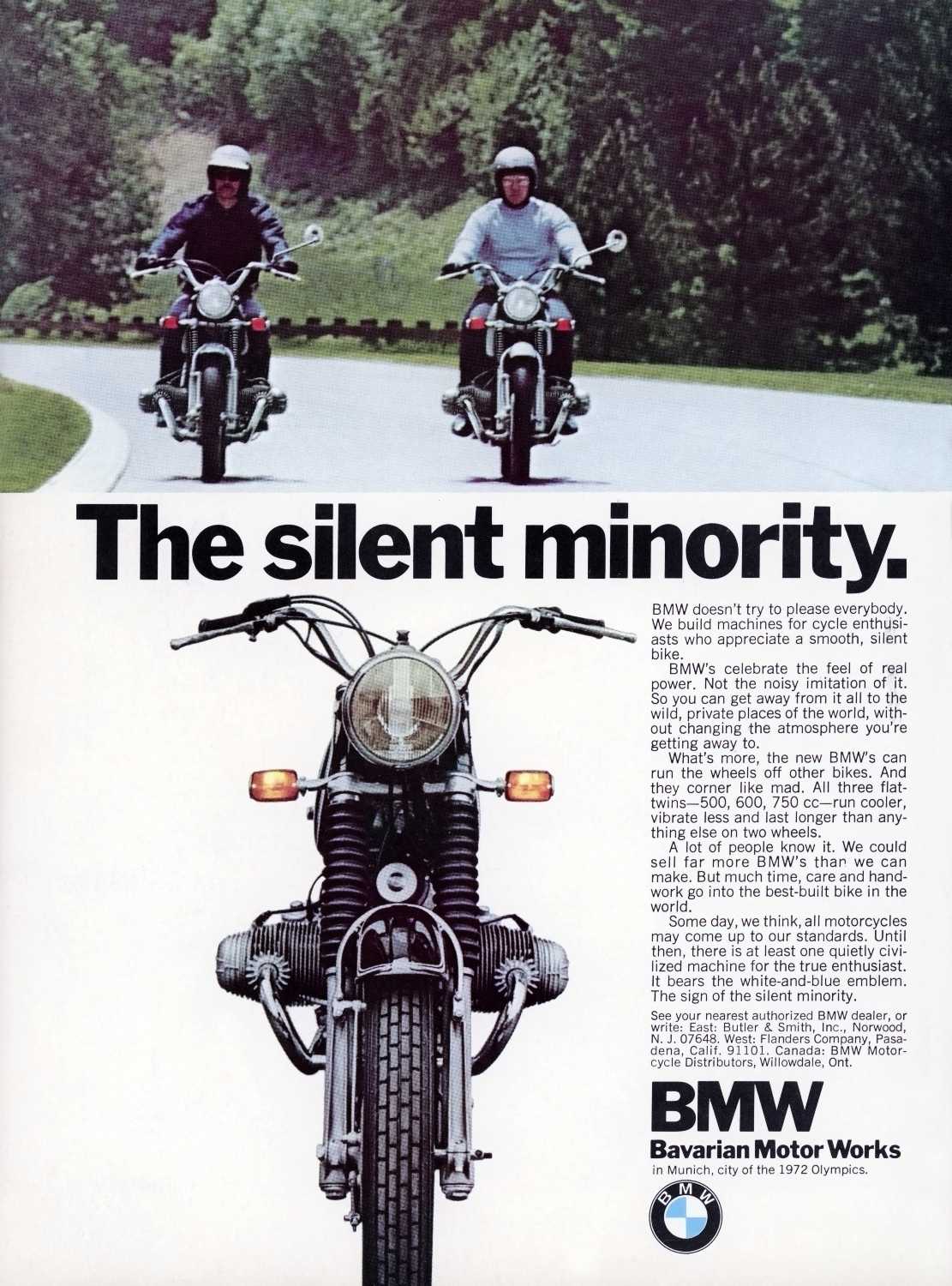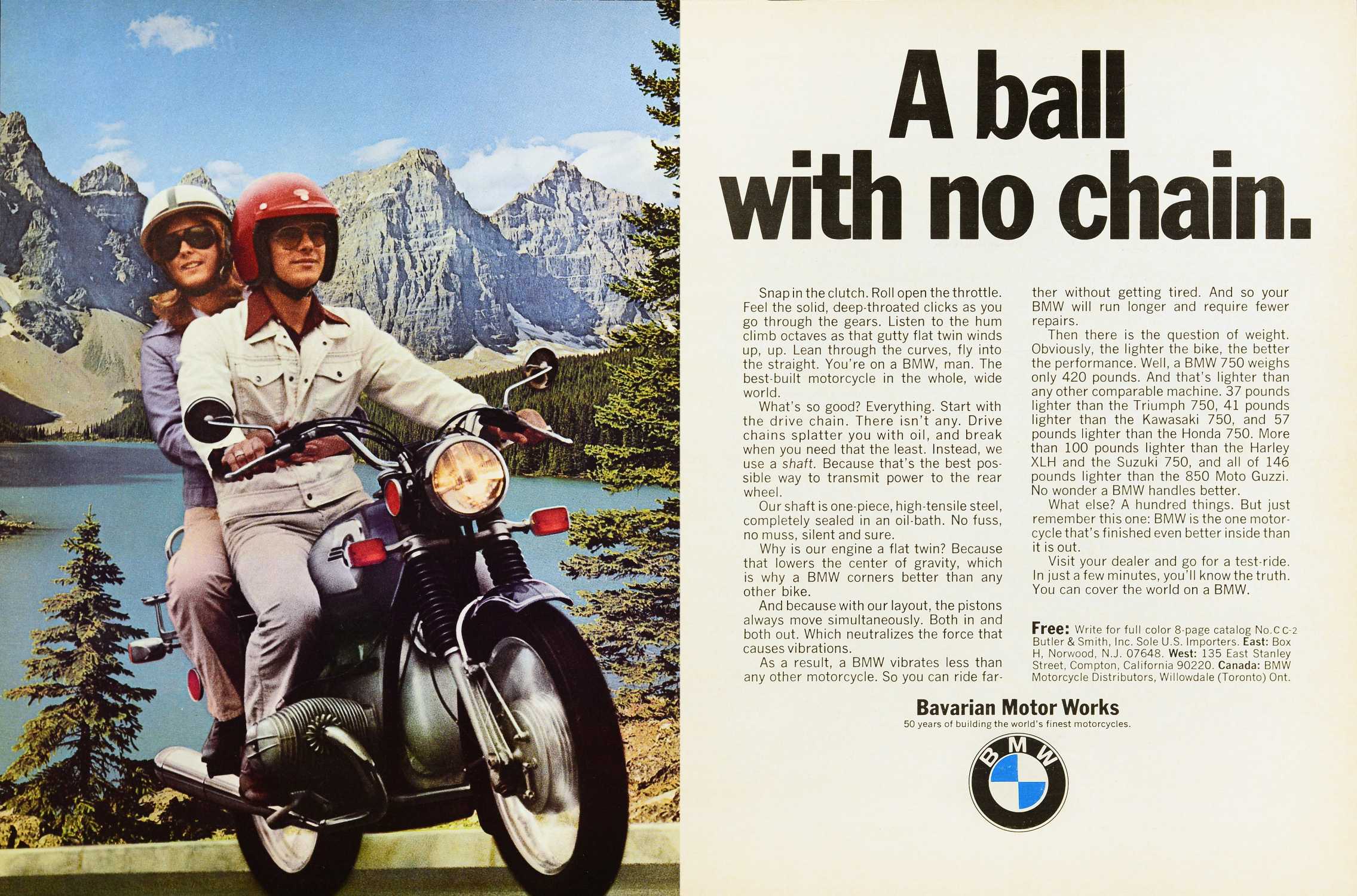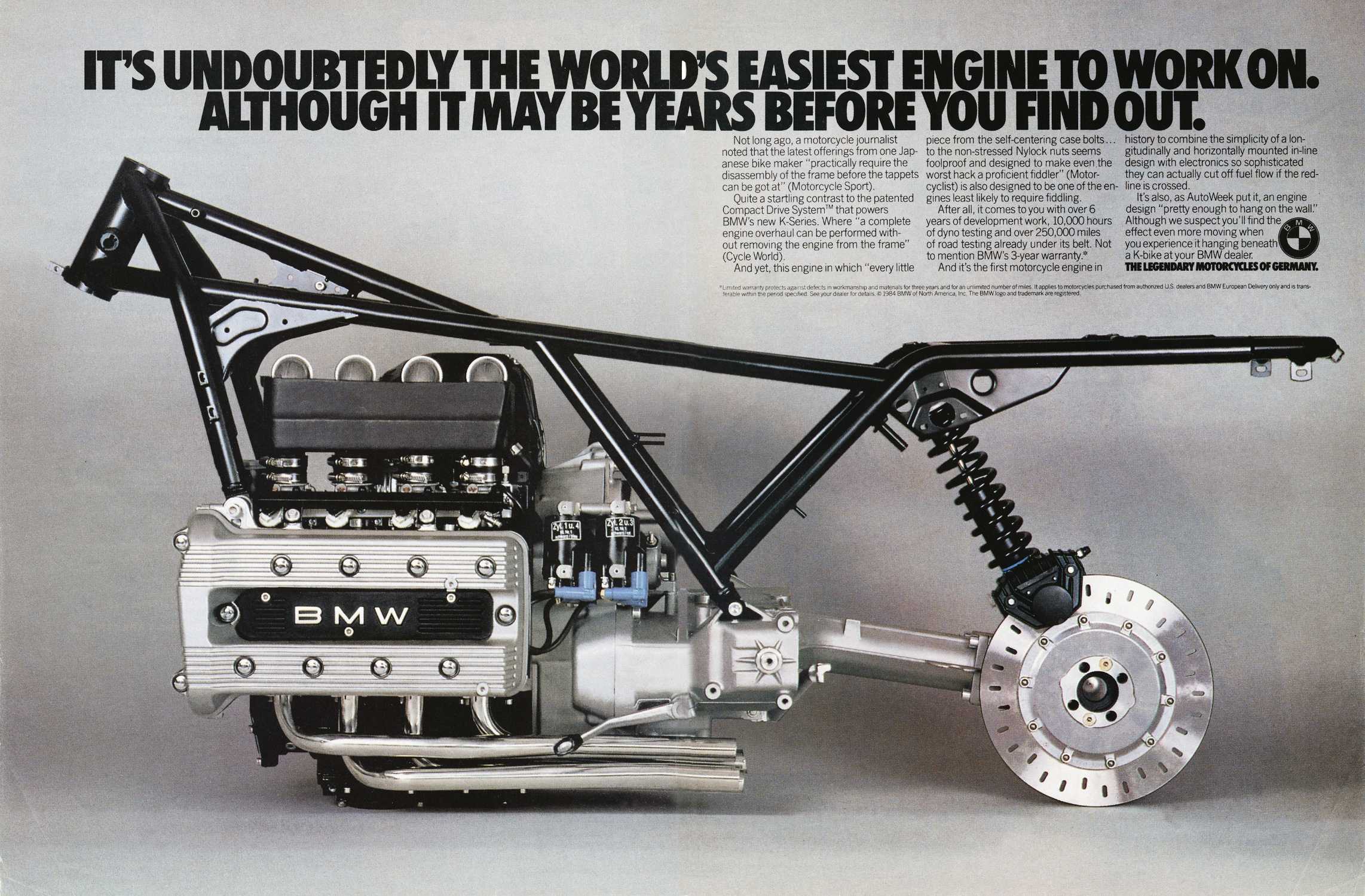Shortly after taking over U.S. sales of BMW automobiles from
independent distributor Max Hoffman in 1975, BMW of North America
initiated the process to do the same for the motorcycle side of the business.
BMW had been exporting motorcycles to the U.S. since 1950, less than
two years after production had resumed in Munich following the
destruction of World War II. At first, bikes were ordered directly by
dealers whose relationship with BMW predated the war, like Oscar
Liebmann, whose New Jersey-based AMOL Precision became the first
official BMW motorcycle dealer in the U.S. in 1950. By the end of that
year, however, the right to distribute BMW’s motorcycles in this
market was assigned to the V. (for Victor) Harasty organization.
Four years later, that privilege was transferred to the Butler &
Smith Trading Company. (Contrary to assumptions, the name of the firm
referred not to its founders but to the intersection in Brooklyn where
the company was located. Butler & Smith first imported NSU
motorcycles from Germany, then Lambretta scooters from Italy.)
On February 19, 1954, Butler & Smith president Alfred Bondy wrote
a letter to inform NSU and BMW motorcycle dealers that Butler &
Smith was BMW’s official U.S. importer. Bondy expressed his desire
that BMW dealers should continue with the new distributor, which would
“combine Germany’s two most prominent brands which are world renowned
for their workmanship and performance.” Bondy also stated that “The
first BMW motorcycles will arrive in a few days. A large quantity of
BMW parts is on order from the factory, and we hope that our
reputation for fast and complete NSU parts service will soon apply to
our BMW parts service.”
Initially, Butler & Smith would handle operations on the East
Coast, with West Coast distribution delegated to the Flanders Company
of Pasadena, California. In 1969, Butler & Smith took over
distribution for the entire U.S., and in May 1970 established a new
headquarters and import center in Norwood, New Jersey.
Even prior to that move, Butler & Smith had ensured that BMW
built motorcycles suited to the needs and tastes of U.S. riders, most
of whom used bikes like the R 50 and R 69 for long-distance touring.
Their suitability for that purpose had been firmly established in
1958, when Ohio dealer John Penton rode his 600cc R 69 from New York
to Los Angeles in 52 hours, 11 minutes, setting a new record and
gaining great publicity for the reliability of BMW motorcycles.
(Penton was an accomplished off-road rider, and he’d ride a
factory-backed R 27 single in the 1962 International Six Days Trial,
winning a silver medal despite a few bad crashes.) Thanks to Butler
& Smith, BMW motorcycles could be ordered in the U.S. with options
like dual seats, higher handlebars, and accessories like saddlebags,
fairings, and the side stands preferred by Americans over the standard
center stand. Later, Butler & Smith would offer aftermarket
equipment including Krauser luggage, Luftmeister fairings, and
Continental or Metzeler tires.
BMW built sporty models as well as touring bikes, of course, and
Butler & Smith went racing to promote them. The firm became
especially active on the racetrack following the move to New Jersey,
which likely coincided with the ascension of Dr. Peter Adams to the
leadership of the Butler & Smith firm. Adams was the son of Butler
& Smith owner Irwin Adams, who may have founded or purchased it
with Bondy in 1949 but who had in any case become its sole owner by 1970.
Adams formed a technologically sophisticated race team led by Udo
Gietl and Todd Schuster, both of whom were innovative fabricators and
technicians. The team got off to a fine start in 1971, campaigning a
thoroughly exotic 750cc machine in the American Motorcycle
Association’s Formula 750 class with riders Reg Pridmore and Gary
Fisher. Five years later, the Butler & Smith team switched to the
R 90 S, and its extensively modified bikes finished 1-2 in the very
first AMA Superbike championship, with Reg Pridmore taking the crown
over teammate Steve McLaughlin.
The elation of that championship would be short-lived, at least where
Butler & Smith was concerned. Having taken over U.S. automobile
sales and distribution from Max Hoffman in March 1975, BMW of North
America was looking to do the same for its motorcycles. Dr. Adams
resisted the takeover, and in 1978 filed suit to retain his
distributorship. BMW of North America prevailed in September 1980, and
that October saw the company take possession of the Butler & Smith
operation at Walnut and Hudson streets in Norwood, New Jersey.
The new division was led by vice-president Jean-Pierre Bailby, who’d
come to North America from BMW France. Joseph Salluzzo served as
national sales manager, with Rolf Kettler as marketing manager. Below
them, many of the motorcycle division’s employees were retained from
Butler & Smith, at least temporarily.
“At that point, all of the employees in sales, parts, and service
were Butler & Smith employees, wondering what happens next,” said
Rob Mitchell. “Eventually, people from BMW NA started filling some
positions. I came about six months later to head up advertising and
promotion, taking over from Rolf Kettler, who’d been sent over
temporarily from Germany. I’d been in sales training, and I got hired
because I was the only person at NA who rode motorcycles. It was a
real trial-by-fire.”
Mitchell worked out of an office in Norwood for the next two years,
until the motorcycle division moved to BMW of North America’s
headquarters in Montvale. In the interim, BMW NA began modernizing
operations for sales and distribution, financing, and technical
training. Imposing new standards allowed BMW to cut the number of U.S.
dealers by half, from around 300 to 150. “Like Hoffman, Butler &
Smith would sign you up as a dealer if you purchased $500 worth of
parts and a [BMW] sign,” Mitchell said. “I visited one dealer in
upstate New York that was in an extension of his house, and which had
a dirt floor in the workshop. Once BMW NA put certain operating
requirements for corporate signage, inventory, facilities, and
technical training—all the normal dealership stuff—dealers like that,
who weren’t willing to step up and make the investment, fell away.”
Replacing Butler & Smith with a modern, efficient sales
subsidiary yielded tangible benefits, Mitchell said. “Back in the old
days, you’d pick up the telephone and order a bike from Butler &
Smith. Now you had a modern business culture for ordering bikes and
parts, signing up for technical training, all of that. Some dealers
were upset that they could no longer continue the way they had before,
but those who stayed on found they could offer a lot more to
customers. And the customers got way better support, too. It’s much
better to go into a dealer and see dozens of new bikes rather than
just one, plus accessories and people anxious to help you.”
As it had with the cars, BMW of North America was hoping to increase
sales of BMW motorcycles in the U.S., and to take advantage of
motorcycles’ burgeoning popularity in this country. (That phenomenon
was due largely to the Japanese manufacturers, who marketed their
lightweight motorcycles to young people as an alternative to cars, and
as a “fun” alternative to heavyweight American machines.) Although
hard data isn’t available for the years immediately before and after
the transition, documents within the BMW Archive record declining
export volumes to the U.S. in the mid 1970s: 10,553 units in 1974;
9,256 units in 1975; and 7,539 units in 1976. Presumably, imports
declined further as the decade wore on. Mitchell doesn’t know the
exact figures, but believes that Butler & Smith was selling
perhaps 2,500 motorcycles per year by the time BMW of North America
took over sales and distribution in 1980.
In 1985, the earliest year for which BMW NA data is available, the
company sold 5,597 motorcycles in the U.S., followed by 6,078 in 1986.
That number represented barely one percent of new motorcycles sold in
the U.S. per annum, but it was a significant improvement nonetheless.
A new ad campaign helped. After an agency review, BMW’s motorcycle
account was moved to Ammirati & Puris, which had created “The
Ultimate Driving Machine” tagline that resonated so strongly with car
buyers. For the motorcycles, Ammirati & Puris came up with another
memorable slogan, “The Legendary Motorcycles of Germany,” which
emphasized the company’s heritage at a time when BMW’s performance was
somewhat tepid compared to that of the Japanese and Italian marques.
Ammirati & Puris placed ads in the Wall Street Journal and Esquire
magazine, hoping to reach upscale customers. This didn’t always work,
Mitchell said. “Motorcyclists are grass-roots people, and prestige
isn’t the biggest thing. It’s a very different group than the car people.”
More important, Mitchell said, was ensuring that BMW NA maintained a
press fleet of new motorcycles, and staged press launches to ensure
that new models were reviewed in motorcycle magazines. Those new
models would themselves help BMW NA succeed, especially after the R 80
G/S caught on with adventure-touring riders following its 1980
introduction. “What started as an oddity—an 800cc, 400-pound dirt
bike—became the most important segment, but it took probably ten years
to really take off.”
In late 1983, BMW would enter another crucial segment, supplementing
its longstanding boxer twin lineup with all-new K bikes powered by
water-cooled three- and four-cylinder engines. “Even longtime boxer
owners seemed genuinely excited by the K bikes,” Mitchell said. “There
was clearly room for both within BMW.”
Today, BMW Motorrad USA offers a full range of motorcycles, from the
entry-level G 310 R and GS to the Superbike-spec M 1000 RR, with all
manner of touring, heritage, urban, and adventure bikes in between. A
wide variety of engines is available, from singles to inline sixes,
plus inline fours, Boxer and parallel twins, and even battery-powered scooters.
BMW Motorrad’s factories in Berlin and elsewhere around the world are
busier than ever, turning out 209,257 bikes in 2023. Of those, 24,176
went to customers in Germany and 21,668 to France, while 17,017 were
delivered to customers in the U.S., BMW Motorrad’s third-largest
motorcycle market worldwide. That number constitutes only a small
fraction of the half-million-plus motorcycles sold in the U.S. last
year, but volume isn’t everything. BMW riders have long been among the
industry’s most enthusiastic riders, especially when it comes to
putting serious mileage on their machines. Just like John Penton’s R
69 in 1959, BMW motorcycles continue to carry their riders quickly and
reliably from coast to coast…and beyond.
—end—


